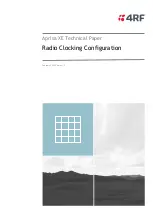
76
Circuit Descriptions
TM8100/TM8200 Service Manual
© Tait Electronics Limited
November 2007
Synthesizer
Circuitry
The essential function of the PLL frequency synthesizer is to multiply a
25kHz reference frequency (30kHz for A4 band, 72kHz for K5 Rx) to give
any desired frequency that is an integer multiple of 25kHz (30kHz for A4
band, 72kHz for K5 Rx). There are some constraints imposed by the
capabilities of the synthesizer hardware, especially the tuning range of the
VCOs.
Reference
Frequency
The approximately 25kHz (30kHz for A4, 72kHz for K5 Rx) reference is
obtained by dividing the approximately 13MHz (2.612kHz for A4) output
of the FCL. Any error in the FCL output frequency will be multiplied by
the synthesizer. Therefore, if the synthesizer is locked but not the FCL, then
the synthesizer output frequency will be wrong. The FCL frequency
division is performed by a digital counter inside the PLL IC. The divider
setting is constant.
VCO Frequency and
Output Power
The output frequency from the synthesizer is generated by a VCO.
The VCO frequency is tuned across the frequency range of the radio by
means of a DC control voltage, typically between 2V and 12V. The VCO
output power is amplified by a buffer amplifier. The power is low and varies
from band to band. The buffer output power depends on which mode—
receive or transmit—is used. In receive mode the output power should be
about 7dBm (0dBm for K5 Rx), whereas in transmit mode it should be
about 9dBm.
Dual VCOs
Some variants of the synthesizer use two VCOs: one for receive and one for
transmit. Synthesizers with two VCOs share the same tuning signal.
Only one VCO is switched on at a time, and so the PLL IC will see only
one output frequency to tune. A portion of the RF output from the VCOs
is fed to the RF input of the PLL IC. The RF signal is divided by an integer
that gives 25kHz (30kHz for A4, 72kHz for K5 Rx) if the output frequency
is correct.
Phase-locked Loop
The PLL IC compares the 25kHz reference (30kHz for A4, 72kHz for K5
Rx) and the divided VCO signal, and the error is used to control the
internal charge pump. The charge pump is a current source that can sink or
source current in proportion to the frequency or phase error. The output is
a series of 25kHz pulses (30kHz for A4, 72kHz for K5 Rx) with a width
that is dependent on the phase error. When the output frequency of the
synthesizer is correct, there is no error and the charge pump output will
become open circuit.
Active Loop Filter
The loop filter continuously integrates the current pulses from the charge
pump and produces a steady DC output voltage that tunes the VCO
(or VCOs). When the VCO frequency is correct, there is no frequency
error and therefore no charge-pump output, and so the loop filter’s output
voltage remains constant. If the frequency is too high or too low, the error
will result in the output of charge-pump current pulses (negative or positive
depending on the sign of the error). The loop filter’s output voltage will
change accordingly, causing the VCO frequency to change in proportion.
The synthesizer design is such that normally the VCO frequency will be
automatically corrected.
Summary of Contents for TM8100 mobiles
Page 1: ...TM8100 mobiles TM8200 mobiles Service Manual MMA 00005 05 Issue 5 November 2007...
Page 10: ...10 TM8100 TM8200 Service Manual Tait Electronics Limited November 2007...
Page 12: ...12 TM8100 TM8200 Service Manual Tait Electronics Limited November 2007...
Page 20: ...20 Introduction TM8100 TM8200 Service Manual Tait Electronics Limited November 2007...
Page 64: ...64 Description TM8100 TM8200 Service Manual Tait Electronics Limited November 2007...
Page 106: ...106 TM8100 TM8200 Service Manual Tait Electronics Limited November 2007...
Page 134: ...134 General Information TM8100 TM8200 Service Manual Tait Electronics Limited November 2007...
Page 168: ...168 Servicing Procedures TM8100 TM8200 Service Manual Tait Electronics Limited November 2007...
Page 464: ...464 Spare Parts TM8100 TM8200 Service Manual Tait Electronics Limited November 2007...
















































